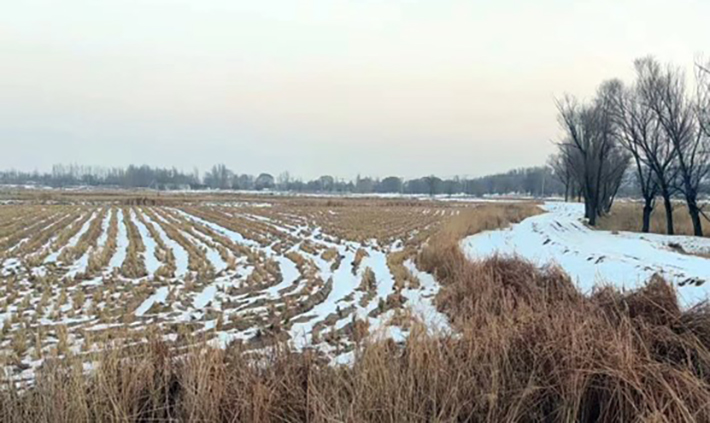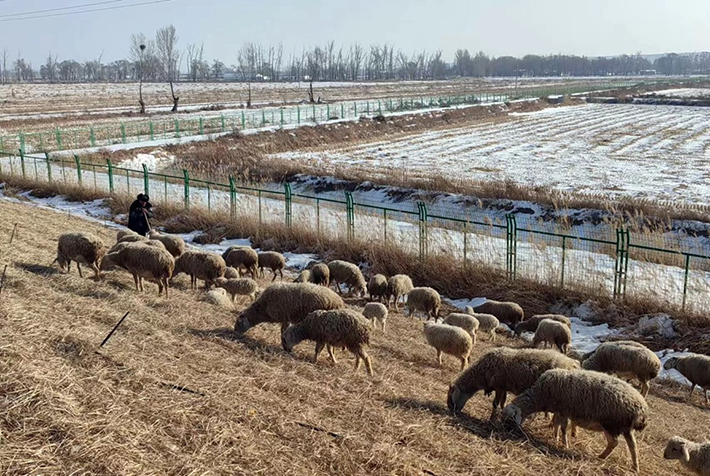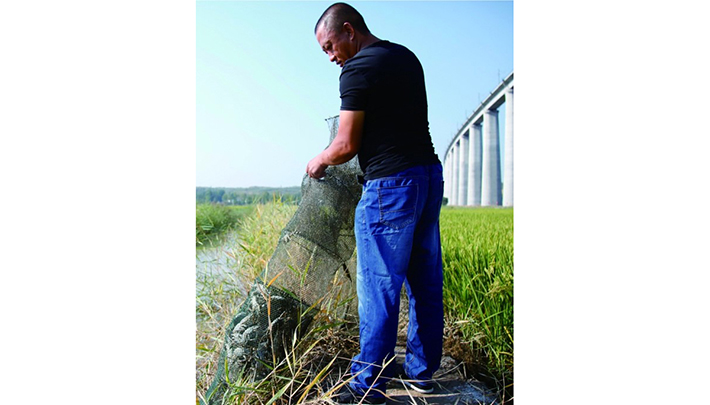
Rice crop is set to mature at the Yellow River Rice-Fish Ecological Sightseeing Park in Xiaotanzi Village, Dalu Town, Jungar Banner, Inner Mongolia Autonomous Region (File Photo)
Winter is not the prime season to visit the rice fields in the village of Xiaotanzi in Dalu Town, Jungar Banner, Inner Mongolia Autonomous Region in north China. More than 1,000 mu (about 67 hectares) of land transformed from saline wasteland is left with rows of stubble.
Summer is when this fertile land truly reveals its splendour with its green paddy fields and water full of fish and crabs, said Qiao Xu, deputy secretary of the village's Party branch.

Photo taken on 29 January shows stubble in a rice field in Xiaotanzi Village, Dalu Town, Jungar Banner, Inner Mongolia Autonomous Region (Yu Xiangjun)
The village, located near the Yellow River, suffered from salinisation as the river's historic fluctuations left their mark on the land. Due to the high salt content in soil, it was difficult for crops and even wild grasses to take root. With meagre harvests, villagers had to abandon cultivation.
The current transformation was inspired by the success story of a village 600 km away - the village of Sishilidian in Helan County of the neighbouring Ningxia Hui Autonomous Region, which was also a victim of salinisation. Villagers there had managed to cultivate rice on the saline-alkaline banks of the Yellow River, and then went a step further and developed a sightseeing park featuring rice-fish ecosystem. After a visit to the village as part as their poverty reduction efforts, Qiao and other members of the Xiaotanzi village committee decided to do the same in their village.
Following the right example
"I was shocked to see that farming could be done in such a way," reminisced Qiao about their pivotal visit. Subsequently, technical experts from the area were enlisted to assess the feasibility of rice cultivation in Xiaotanzi Village. The results were promising: low heavy metal content, absence of pesticide residues, and favourable soil conditions. Coupled with the ample water resources provided by the Yellow River, conducive climatic conditions, abundant sunlight and pristine air, the stage was set for starting rice cultivation.

Sheep graze near a rice field in Xiaotanzi Village, Dalu Town, Jungar Banner, Inner Mongolia Autonomous Region, on 29 January (Yu Xiangjun)
How can rice thrive in saline-alkaline soil? The villagers, who were accustomed to maize cultivation, voiced scepticism, impeding the progress in transferring their land for the cause. Village officials had to visit one household after another to negotiate with the villagers. Eventually, they collected 1,140 mu (about 76 heatares) of saline-alkaline land and dilapidated fish ponds.
Soon, through collaborative efforts between the government of Dalu Town and Chengze, a local company focusing on ecological agriculture and agritourism, Yellow River Rice-Fish Ecological Sightseeing Park, was established, integrating multiple areas of operation such as agriculture, aquaculture and tourism.

A villager catches crab in a rice field in Xiaotanzi Village, Dalu Town, Jungar Banner, Inner Mongolia Autonomous Region (File Photo)
"Apart from rice, there are fish and crabs in the fields, which are connected to fishponds, forming a three-dimensional system," said Qiao Sheng, deputy general manager of the park. According to him, only organic fertilisers are used for the system, where river crabs and fish serve as natural weed and pest controllers, while also aerating the soil for rice cultivation. Their excrement enriches the rice paddies. The water of the Yellow River was introduced to flow through the channels surrounding the rice fields to wash away salt, thus improving soil conditions.
“The rice we produce feature plump grains, crystal appearance, and tender texture. Despite a higher price, demand for our rice remains insatiable,” Qiao said.
The success has changed the thinking of former sceptics. In 2022 alone, the transfer of an additional 160 mu (about 10.7 hectares) of land translated into tangible benefits for 258 households and 774 individuals. So far, 1,500 mu (100 hectares) of village’s saline-alkaline land has already been transformed, out of a total of 2,500 mu (166.7 hectares). The village is poised to convert a further 400 mu (16.7 hectares), ensuring prosperity for all its residents.
Sixty-five-year-old Zhang Zhaozhao is a veteran farmer in the village. Besides transferring his 8 mu (about 0.5 hectares) of saline-alkaline land, he has become a formal employee at the ecological sightseeing park, securing a stable income. Reflecting on past earnings from corn and potatoes, which barely amounted to 20,000 yuan ($2,781) annually. However, Zhang now enjoys a substantial increase, earning up to 60,000 yuan ($8,343) per year.
Cultivating an attraction
The park not only grows rice but also creates art. Liu Hui, deputy general manager of the park, highlighted the diverse hues of over 100 mu (about 6.7 hectares) of coloured rice, ranging from green to red, yellow, purple, black and white. Through the blending of computer-aided design, satellite positioning and manual labour, these fields are turned into breathtaking works of art. As the rice plants become lush green in July and August, visitors are treated to a visual feast, enhanced by observation towers and glass walkways thoughtfully integrated within the park.
These grandiose rice field paintings have captured the imagination of countless tourists, attracting over 100,000 visitors during just three months from July to October in 2023, according to Liu. The burgeoning popularity of the sightseeing park has catalysed growth across more than 70 local agritainment entities.

Giant rice field paintings are seen in Xiaotanzi Village, Dalu Town, Jungar Banner, Inner Mongolia Autonomous Region (File Photo)
Empowered by the park, villagers partake in the bounty of a thriving tourism industry. Annual bonuses distributed by the park contribute further to communal prosperity. With farmhouses being transformed into vibrant guesthouses, villages are evolving into bustling tourist hubs, and once-barren saline-alkaline land is turning into fields of golden opportunity, turning the village into a beacon of hope and drawing scores of young entrepreneurs back to their roots.
In March 2023, despite opposition from her father, 27-year-old Qiao Jia quit her stable job at a state-owned company to embark on a new venture, opening a guesthouse in the village. Armed with astute Internet familiarity and a keen eye for market trends, she curated a menu brimming with local delicacies, attracting patrons from far and wide. With a turnover exceeding 400,000 yuan ($55,593) last year and reservations fully booked for the Lunar New Year festivities, Qiao harbours unwavering confidence in the future of the village's development model.